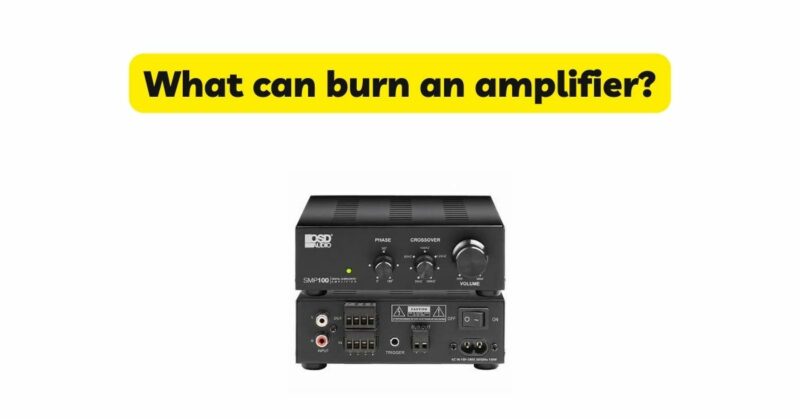Amplifiers are vital components in audio systems, providing power and enhancing the quality of audio signals. As with any electronic device, amplifiers are susceptible to damage and failure under certain circumstances. One of the most concerning issues that can occur is an amplifier burning. In this article, we will explore the factors that can potentially cause an amplifier to burn, helping you understand the risks involved and providing insights into protecting your valuable audio equipment.
Understanding Amplifier Design and Operation
Before delving into the causes of amplifier burns, it is essential to grasp the basic design and operation of amplifiers. Amplifiers receive low-power audio signals and increase their amplitude to a level suitable for driving speakers. They consist of various components, including transistors, capacitors, resistors, and power supply units.Amplifier burns typically result from excessive heat generation, which can damage critical components or lead to thermal runaway, a condition in which the amplifier’s internal temperature rises uncontrollably. Therefore, understanding the factors that contribute to heat build-up is crucial for preventing amplifier burns.
Potential Causes of Amplifier Burns
- Overheating due to inadequate ventilation: Insufficient airflow and poor ventilation can cause an amplifier to overheat, leading to component failure or even fire. Amplifiers generate heat during operation, and if not properly dissipated, the temperature can rise to dangerous levels. Factors such as the placement of the amplifier in an enclosed space, blocked ventilation grilles, or stacking equipment tightly together can impede proper heat dissipation.
- High ambient temperature: Operating an amplifier in an environment with high ambient temperatures can exacerbate heat-related issues. If the surrounding temperature is already elevated, the amplifier’s cooling mechanisms may struggle to dissipate the heat effectively. This situation puts additional stress on the components and can increase the risk of burns or damage.
- Incorrect load impedance: Impedance matching is critical for amplifiers and speakers. Connecting speakers with an impedance lower than the amplifier’s specified rating can overload the amplifier and cause it to work harder, generating excessive heat. This can lead to component failure or damage.
- Power supply issues: Problems with the power supply can also contribute to amplifier burns. Insufficient power supply voltage or current can cause the amplifier to draw more current than it can handle, leading to overheating and eventual failure. Conversely, power supply surges or irregularities can introduce excessive voltage or current, which can damage the amplifier’s components.
- Overdriving the amplifier: Pushing the amplifier beyond its rated limits, such as driving it into clipping or continuously playing audio at maximum volume, can cause it to work harder and generate more heat than it is designed to handle. Prolonged operation under such conditions can result in component failure or even burn.
- Manufacturing defects: While relatively rare, manufacturing defects can also contribute to amplifier burns. Faulty components, improper soldering, or design flaws can lead to abnormal heat generation or other issues that increase the risk of amplifier burns.
Protecting Your Amplifier: Tips and Best Practices
Prevention is key when it comes to avoiding amplifier burns. Here are some tips and best practices to protect your amplifier and ensure its longevity:
- Proper ventilation and airflow: Ensure that your amplifier has adequate space for ventilation. Place it in an open area with sufficient clearance around it to allow proper airflow. Avoid enclosing the amplifier in cabinets or racks without proper ventilation. Regularly clean the amplifier’s vents and cooling fans to prevent dust buildup.
- Avoid high ambient temperatures: If possible, keep your amplifier in a room with a controlled temperature. Avoid placing it near heat sources or in direct sunlight. If operating in warm environments is unavoidable, consider using additional cooling methods, such as fans or dedicated cooling systems.
- Match impedance correctly: Always connect speakers with the appropriate impedance rating for your amplifier. Check the specifications of both the amplifier and the speakers to ensure proper impedance matching. This will prevent excessive strain on the amplifier and minimize the risk of burns.
- Use a stable power supply: Ensure that your amplifier is connected to a stable power supply. Consider using power conditioners or surge protectors to safeguard against power surges and fluctuations. Verify that the power supply voltage and current meet the amplifier’s requirements.
- Avoid overdriving the amplifier: Use the amplifier within its specified power ratings and avoid continuous operation at maximum volume or in clipped conditions. Monitor the audio levels and keep them within a safe range to prevent excessive heat generation.
- Regular maintenance and inspections: Perform regular maintenance on your amplifier, including checking for loose connections, inspecting cables for damage, and cleaning the amplifier’s exterior. Schedule professional inspections and servicing to detect and address any potential issues before they escalate.
Conclusion
Amplifier burns are a serious concern that can lead to equipment damage, loss of performance, or even safety hazards. Understanding the potential causes of amplifier burns and implementing preventive measures can go a long way in protecting your audio equipment. By ensuring proper ventilation, impedance matching, stable power supply, and responsible use of the amplifier, you can enjoy optimal performance and prolong the lifespan of your amplifier while minimizing the risk of burns.


